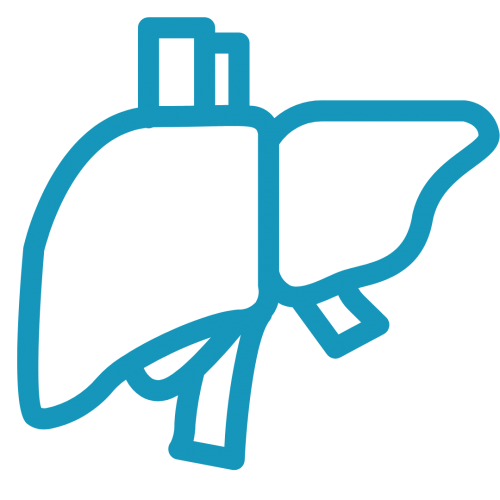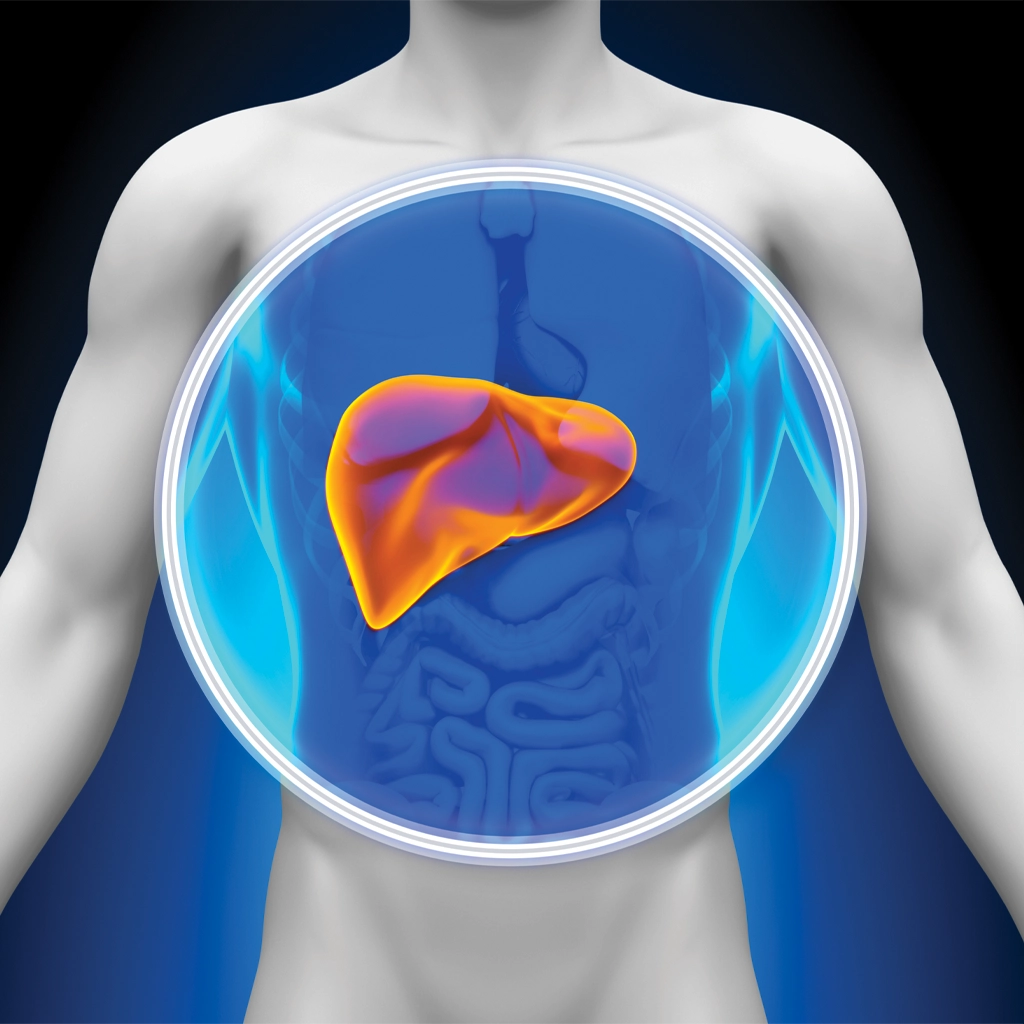Liver Cancer Care
What is Liver Cancer?
Liver cancers include cancers that develop from the liver or spread from another organ to the liver. Patients who develop cancers from the colon, pancreas, breast and other organs are at risk of cancer spread to the liver.
Who is at risk?
Patients with cancers in other organs, such as the colon, pancreas and breast, are at risk of cancer spread to the liver. Patients with a history of liver disease such as hepatitis or cirrhosis are at higher risk of developing primary liver cancer.
What is liver-directed therapy?
Liver-directed therapies are minimally invasive, same day procedures, designed to treat liver cancers to improve the quantity and quality of life. Yttrium-90 (Y90) radioembolization, trans-arterial chemoembolization (TACE) and ablation are some types of liver-directed therapies.
What does the research say?
Liver-directed therapies can be delivered safely in combination with systemic treatments such as chemotherapy, targeted therapies and/or immunotherapy. Many studies show that liver-directed therapies can improve the effectiveness of certain systemic therapies.

Dr. Kim Explains Exciting Outpatient Treatment Options
Did you know that there are outpatient treatment options to make liver cancer treatment more effective? Our expert physicians at #NVP do!
There are 2 Primary Types of Liver Cancer
Primary Liver Cancer
Primary liver cancers are cancers that originate from the liver and include hepatocellular carcinoma (HCC) and bile duct cancers, or cholangiocarcinoma. HCC accounts for approximately 90% of primary liver cancers. The 5 year overall survival rate for patients with this disease is 20% but can be curable if the disease is localized to the liver. Patients with underlying liver disease such as cirrhosis, hepatitis B and hepatitis C are at highest risk.
Secondary (Metastatic) Liver Cancer
Secondary liver cancers are cancers which have spread to the liver from another part of the body. Most patients with disease spread to the liver are considered not to have curable disease. However, many patients with colorectal, pancreatic, neuroendocrine, breast, kidney and other cancers may benefit from additional treatment directed to the tumors which have spread to the liver.
Yttrium-90 (Y-90) Radioembolization, also known as Trans-Arterial Radioembolization (TARE)
Yttrium-90 (Y-90) radioembolization, also known as trans-arterial radioembolization (TARE) is performed on 2 or 3 separate days, depending on the amount of tumor in the liver. A planning procedure, mapping angiogram, is initially performed to determine if the patient is eligible to receive the treatment.
The procedure begins with a tiny incision in the groin area or wrist. This incision provides the Interventional Radiologist (IR) with access to arteries that feed the liver cancer. Using specialized X-ray equipment, the IR passes a catheter (small tube) into the incision to the hepatic artery, and guides it near the location of the tumor.
When the IR has reached the location of the tumor, a test radiation particle (Tc99-MAA) radiation particles are injected through the catheter and into the blood vessels feeding the tumor. Once the radiation particles have been injected, the catheter is gently removed. The patient then undergoes a nuclear imaging study to assess how arterially delivered radiation is distributed in the body.
Once the planning procedure confirms safety of treatment, the patient returns within 1 week to receive the Y-90 radiation treatment. The procedure is essentially identical to the mapping procedure with the exception that Y-90 particles are delivered instead of the test radiation. Depending on the location and amount of tumor in the liver, the Y-90 delivery may be repeated after 2-4 weeks from initial treatment.
These procedures do not require an overnight stay and typically last less than 1 hour. Patients are discharged from the outpatient center after a 2 hour observation post procedure.

Is Yttrium-90 Radioembolization (Y-90) right for me?
You may be a candidate for Y-90 if:
- You have disease which cannot be cured with surgery
- You do not want surgery
- You are looking for additional therapies in addition to systemic chemotherapy
- You are looking to enhance effectiveness of immunotherapy
Y-90 Treatment Option
Y-90 radioembolization is a minimally invasive, same day procedure where high doses of radiation particles are delivered from the artery supplying the liver with blood. The radiation particles then travel to the tumors killing tumor cells. As tumors receive more blood from the artery compared to the normal background liver, injected radiation particles are preferentially imbed in the tumor while limiting radiation exposure to the background normal liver. This type of internal radiation delivery allows for a higher dose of radiation to be delivered to tumors compared to external radiation and has been associated with complete tumor destruction.
Key Advantages
The effectiveness of all of the local therapy options have been extensively studied and validated through a number of clinical trials. Like other minimally invasive procedures, these therapies can have significant benefits for cancer patients.
Benefits
- Performed in addition to systemic chemotherapy, targeted therapy and/or immunotherapy to maximize therapeutic outcomes
- Potential to enhance effects of immunotherapy
- Typically performed as an outpatient procedure
- Virtually no blood loss
- Safe procedures that involves minimal risk and low rates of complications
- Overall, significant improvement in patient’s physical and emotional well-being
- Covered by most insurance companies
Risks
Although complications from local cancer therapies are rare, any medical procedure carries some degree of risk. Despite the low risk factor, it is important to understand the potential complications associated with these treatments. These include:
- Post-embolization syndrome (post-procedure pain, fever, tiredness, and elevated white blood cell count)
- Bleeding
- Infection
- Injury to liver, lung or other organs
Other Treatment Options
Trans-Arterial Chemoembolization (TACE)
TACE is performed on 1 or 2 separate days, depending on the location and amount of tumor in the liver.
The procedure begins with a tiny incision in the groin area or wrist. This incision provides the Interventional Radiologist (IR) with access to arteries that feed the liver cancer. Using specialized X-ray equipment, the IR passes a catheter (small tube) into the incision to the hepatic artery, and guides it near the location of the tumor.
When the IR has reached the location of the tumor, particles bound to chemotherapy are injected through the catheter and into the blood vessels feeding the tumor. Once all of the particles have been injected, the catheter is gently removed.
These procedures do not require an overnight stay and typically last less than 1 hour. Patients are discharged from the outpatient center after a 2 hour observation post procedure.
Percutaneous Ablation
Percutaneous ablation includes radiofrequency ablation (RFA), cryoablation and microwave ablation.
These procedures begin with an assessment of the tumor with an ultrasound and/or CT scan. Once the tumor is localized, a small needle is advanced under direct imaging guidance to accurately position the needle in the tumor. The tumor is then burned or frozen depending on the type of ablation used.
These procedures do not require an overnight stay and typically last less than 1 hour. Patients are discharged from the outpatient center after a 2 hour observation post procedure.
Cancer Pain
Cancer can cause debilitating pain for many patients. Fortunately there are a number of minimally invasive, same day procedures which have been proven in multiple studies to reduce pain and dependence on opioids. The pain reducing effects of these procedures is significantly faster than radiation therapy, but can be used in conjunction with radiation.
Treatment Options
Vertebral Augmentation
Vertebral augmentation, also known as vertebroplasty or kyphoplasty, is a minimally invasive procedure designed to reduce the pain and loss of function associated with spine compression fractures which often arise from cancer metastasis. Vertebral augmentation is typically performed under moderate sedation with the patient asleep but arousable. One or two small needles are advanced under advanced x-ray guidance into the fractured vertebral body. A special balloon may be used to lift up the fractured vertebrae to restore height. Medical cement-like material called polymethylmethacrylate (PMMA) is then injected to immediately stabilize and restore strength to the fractured vertebrae. Pain relief is immediate for some patients and most patients see improvement within 48 hours.

Bone Embolization
Bone embolization is a minimally invasive procedure where small medical beads are injected into bone tumors through the artery. Bone embolization is typically performed under moderate sedation with the patient asleep but arousable. A number of studies demonstrate that bone embolization can lead to reduced pain and decrease dependence on opioids. This treatment can work in conjunction with radiation therapy but provides significantly faster results.
Bone Ablation
Bone ablation is a minimally invasive procedure where tumors in bone are destroyed by heating or freezing the tumors. Multiple studies have shown that bone ablation can significantly reduce pain levels and decrease dependence on opioids. Bone ablation and embolization are sometimes performed sequentially to maximize their effectiveness. As with embolization, the pain reducing effects of these procedures is significantly faster than radiation therapy, but can be used in conjunction with radiation.
Nerve Blocks and Ablation
Nerve blocks are minimally invasive procedures where painful nerves are targeted and sometimes destroyed. Patients can experience significantly reduced pain after these procedures.

Other Conditions
Neuroendocrine Tumor
Neuroendocrine tumors (NETs) are a rare type of tumor that arises from specialized cells called neuroendocrine cells. These tumors can develop anywhere in the body, most frequently in the small intestine, appendix, pancreas or the lungs. They frequently spread to the liver which can lead to various symptoms including flushing, heart palpitations, and diarrhea. Local therapies can help relieve the symptoms of NETs and may potentially improve patients’ life span.
Kidney Cancer (Renal Cell Carcinoma)
Kidney cancer is a disease which arises from the lining of tubules in the kidney. Smoking and misuse of certain pain medications put patients at a higher risk of developing these tumors. Some signs of this disease include blood in the urine or pain in the side which will not go away.
Pancreatic Cancer
Pancreatic cancer originates from the pancreas, an organ behind the stomach. Patients are generally diagnosed late in the disease process as in early stages, affected patients are typically not symptomatic. Patients may present with unexplained weight loss or jaundice, yellowing of the skin and eyes.
Breast Cancer
Breast cancer is cancer that forms in the cells of the breast. The great majority of breast cancers occur in women with men accounting for 1% of cases. Although 99% of patients with localized breast cancer liver >5 years, the 5 year survival for patients with distant metastases is only 29%.
Bone Cancer
Similar to liver cancer, bone cancers can arise directly from the bone or more commonly, spread from another site of origin. Many patients with bone cancers can experience debilitating pain from these tumors.






